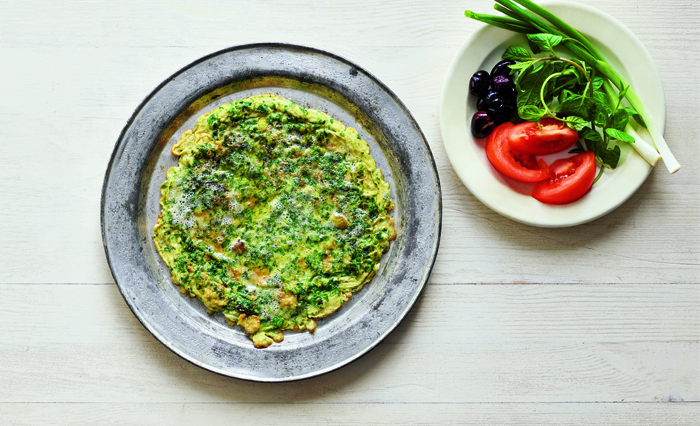Before ‘zero waste’ was a phrase, there was just using what you had.
Boiling a chicken carcass for broth was what you did because you’d like to eat again tomorrow, rather than to create a youth-giving elixir. Soaking stale bread to make it edible was so that you had something for lunch, rather than to make a panzanella to take Instagram snaps of.
One cuisine that’s creative with this side of things is Palestinian. Currently making waves, (chef Joudie Kalla’s ‘Palestine On A Plate supperclubs sell out around London, while Soho’s Tabun Kitchen is gaining popularity as a healthy after-work hangout) it’s an olive oil drenched, pomegranate-studded and labneh-flecked muddle of herby, sweet and zingy.
Vegetable-forward and resourceful, it’s a good one to add to any sustainable cook’s repertoire. Here’s your cheat sheet on how it’s done from Reem Kassis, the Palestinian born, US-living author of ‘The Palestinian Table,’ cookbook (Phaidon, £24.95, out now).
Palestinian food is local and seasonal
“From the greens we forage throughout the year, to the local produce we harvest in season and then preserve (via pickling and making molasses and cordials) to the meat and dairy we consume (the latter is mostly from sheep and goats) and the grains we use, like bulgur and freekeh, Palestinians eat food that’s found in our local landscape.”
There’s a zero-waste mentality
“There’s a reluctance to throw anything out. A zero-waste mentality if you will. Perhaps this way of living originally arose out of poverty, but, nonetheless, it’s deeply ingrained in the way we cook and eat.
This can be seen in lots of recipes in the book which are often made of leftovers: we cook leftover fish in a tahini sauce and make baba ghanouj with fried aubergines from making maqlube, [a stewed rice dish that’s cooked in a big pot, upside down] for example.”
You eat what you need – no more
“Rather than portioning meals into set sizes in which someone feels compelled to finish their plate, we serve meals family-style. This helps to eliminate waste, as people don’t eat more than they want to be polite.
This type of food also lends itself better to leftovers. So our stews and pilafs, as well as our large roasts, often taste just as good the following day. Where they might not, we have recipes for what to do with the remains.
Also, having multiple dishes means we don’t rely on exclusively on one component to satiate our hunger. We don’t eat an 8oz steak – instead, we’ll have a small portion of meat, oftentimes incorporated into a dish with multiple vegetables and/or grains, and perhaps spreads and bread.”
Our food relies on vegetables and legumes
“With the exception of some festive dishes, most of our food, even things that do include meat, don’t have it as the star of the dish. Mjadarah (a lentil and bulgur pilaf) is one of the most popular vegetarian meals for Palestinians, especially with a side of salad and yogurt.
Pastries are a wonderful vegetarian option, as are our filling salads with grains. All of our stews can be prepared in vegetarian form – you often see Christians in Palestine doing this all throughout Lent.”
But we know how to make them sing
“Historically, meats were also often expensive and reserved for special occasions. To this day, it’s seen as a sign of respect to serve guests large pieces of meat. We became adept at taking humble fruits and vegetables and turning them into beautiful and delicious dishes.
Things like smooth rocket yogurt and crunchy vegetable salads, cool tomato relish and warm dandelion with caramelised onions, as well as fried vegetables are combined with grains and legumes and some dairy to result in a holistic and healthy diet.
I love Palestinian food because to me it’s more than something to eat. It’s a narrative that keeps me close to my family and my culture. But, from a pure taste perspective, I love how fresh and sharp the flavours can be – and how soul-soothing many of the dishes are.
One of my favorite things, actually, is looking through some of my recipes with only a handful of ingredients and thinking “how could so few things possibly produce something so delicious?!” and yet, time and time, again they do.
Palestinian dishes are, quite often, much more than the sum of their parts.”
Fancy giving it a go? Try Reem’s recipe for Palestinian frittata.

Ingredients:
8 eggs
4 spring onions, finely chopped
25 g flat-leaf parsley, finely chopped
25 g fresh mint leaves, finely chopped
1 large clove garlic, crushed
1 green chilli, seeded and finely chopped (optional)
1 teaspoon salt
½ teaspoon ground cumin
¼ teaspoon black pepper
1 tablespoon plain flour olive oil, for frying
To serve: olives, spring onion, mint and tomato, labneh, pita bread
Method:
Break the eggs into a large bowl and whisk until the mixture is pale yellow and starting to froth. Add the chopped herbs, garlic, chilli, salt, and spices and mix until evenly combined.
Sprinkle the flour over the eggs and whisk until incorporated. Heat a generous amount of olive oil in a skillet (frying pan) over medium-high heat. You can use one very large pan or a small one and work in batches. I prefer using a smaller pan and making several really thin omelettes as they come out crispier this way, adding more oil to the pan after each frittata.
Once the oil is hot, pour the mixture into the pan, tilting it around to get an even layer of eggs. Cook until the edges start to curl and the top is starting to solidify, periodically lifting with a spatula to make sure the bottom is not burning.
When the frittata is no longer runny on the top, flip it over to brown the other side. Continue to cook for another minute or two until done, then slide the frittata onto a plate.
If using a small pan, repeat, adding more olive oil, until the egg mixture is all used up. Serve immediately with fresh pita bread and a side of labaneh.
See also:
This Is Why Buying Stuff Will Never Make You Happy
This Woman Wants To Make Your Sex Sustainable
Netflix Films That’ll Spark Your Love Of Sustainable Living
